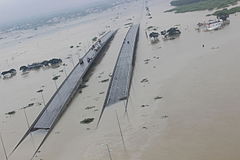2015 Chennai floods

Submerged bridges in Chennai
|
|
| Date | 8 November 2015 – 14 December 2015 |
|---|---|
| Location | South India (Tamil Nadu, Puducherry, Andhra Pradesh) |
| Deaths |
500+ Andhra Pradesh: 81 Puducherry: 3 |
| Property damage |
₹19,895 crore (US$3 billion) – over ₹100,000 crore (US$16 billion) (unofficial estimates) Andhra Pradesh: ₹4,960 crore (US$773 million) Pondicherry: ₹333 crore (US$52 million) |
500+
₹19,895 crore (US$3 billion) – over ₹100,000 crore (US$16 billion) (unofficial estimates)
The 2015 South Indian floods resulted from heavy rainfall generated by the annual northeast monsoon in November–December 2015. They affected the Coromandel Coast region of the South Indian states of Tamil Nadu and Andhra Pradesh, and the union territory of Puducherry, with Tamil Nadu and the city of Chennai particularly hard-hit. More than 500 people were killed and over 18 lakh (1.8 million) people were displaced. With estimates of damages and losses ranging from nearly ₹200 billion (US$3 billion) to over ₹1 trillion (US$16 billion), the floods were the costliest to have occurred in 2015, and were among the costliest natural disasters of the year. The flooding has been attributed to the 2014–16 El Niño event.
From October to December each year, a very large area of south India, including Tamil Nadu, the coastal regions of Andhra Pradesh and the union territory of Puducherry, receives up to 60 percent of its annual rainfall from the northeast monsoon (or winter monsoon). The northeast monsoon is the result of the annual gradual retreat of monsoonal rains from northeastern India. Unlike during the regular monsoon, rainfall during the northeast monsoon is sporadic, but typically far exceeds the amount produced by the regular monsoon by up to 90 percent. This excessive rainfall can be exacerbated by an El Nino year, which 2015 was.
The coastal districts of Andhra Pradesh usually bear the brunt of heavy rains that occur during the northeast monsoon; with numerous river systems and wetlands, Puducherry and eastern Tamil Nadu are prone to flooding. The city of Chennai alone experienced five major floods between 1943 and 2005, with the 1943, 1978 and 2005 floods causing particularly severe damage. In addition, unplanned and often illegal urban development has led to many wetlands and natural sinks being built over; this, along with ageing civic infrastructure and poorly designed drainage systems, has resulted in an increased frequency of severe flooding.
...
Wikipedia
